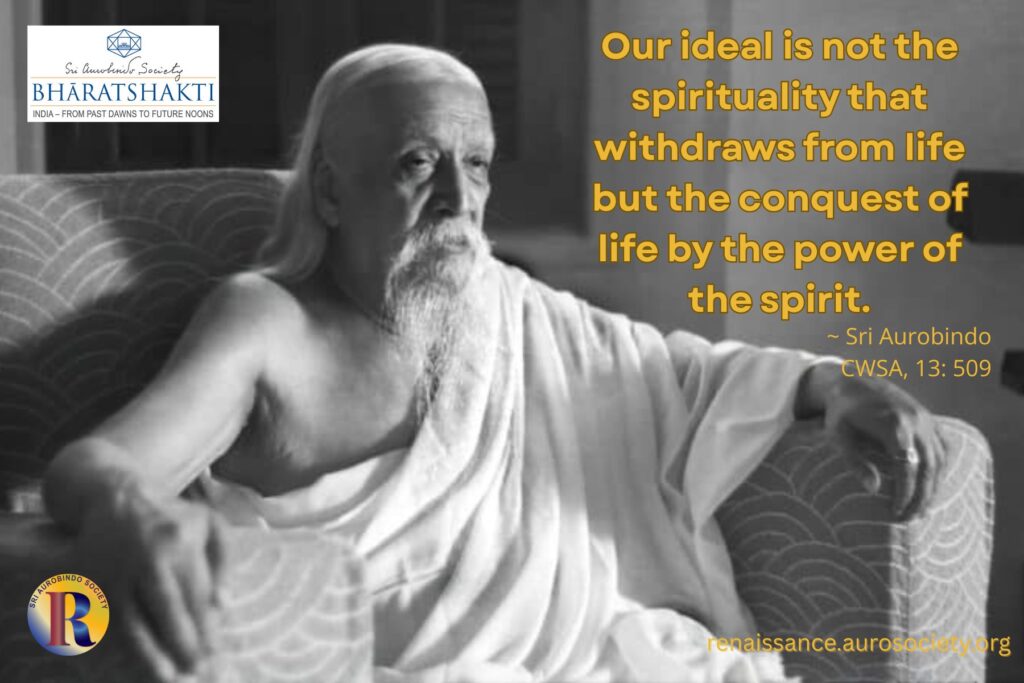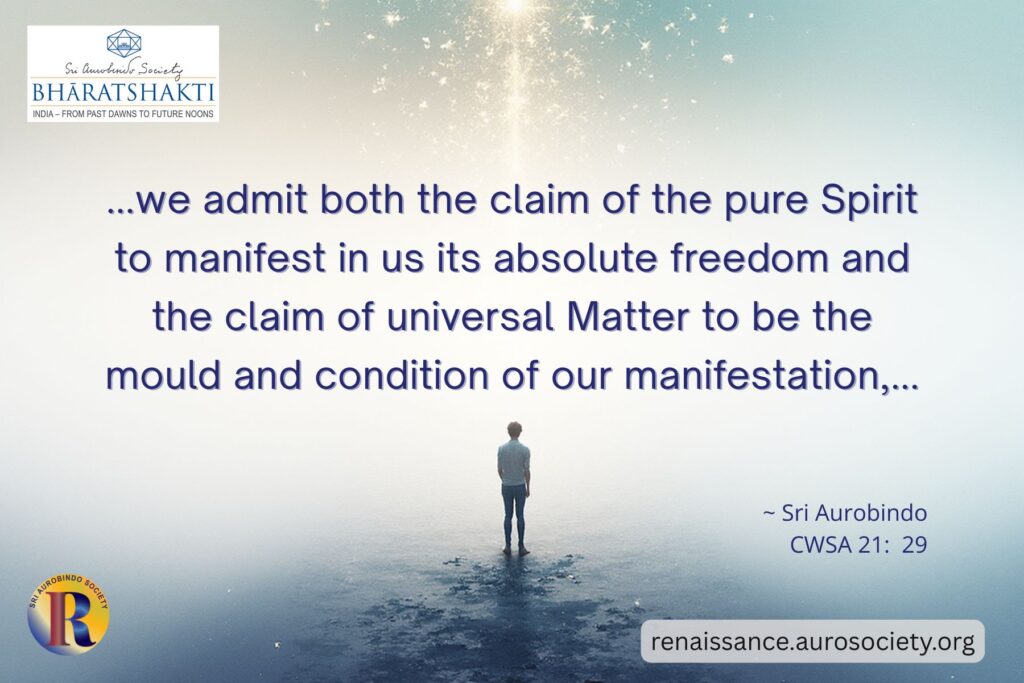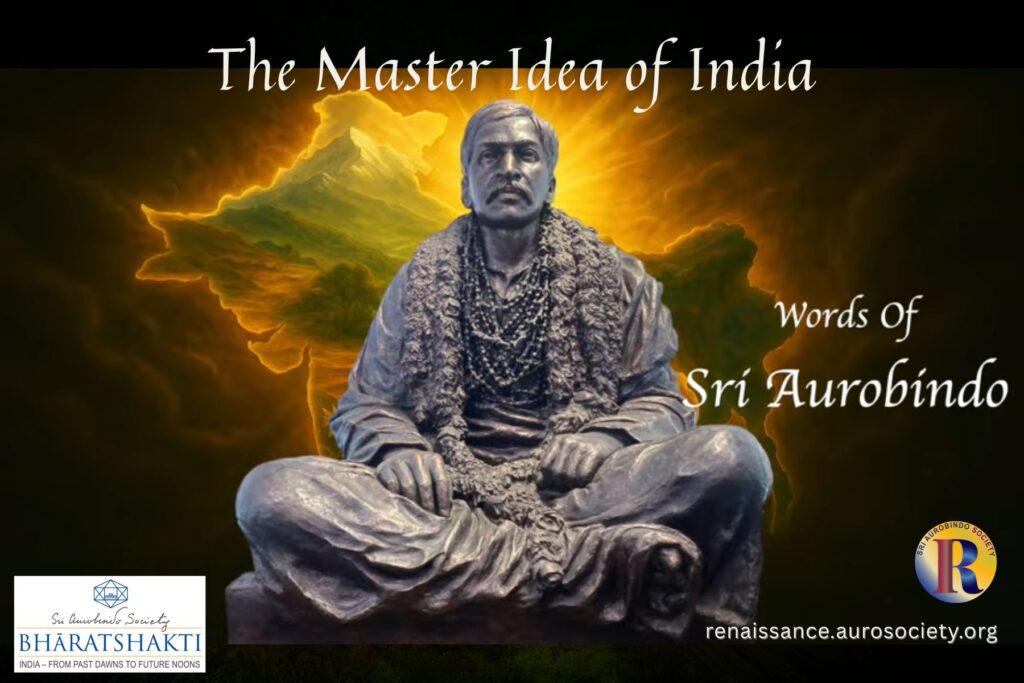CONTINUED FROM PART 1
The religio-spiritual culture which presently goes by the name of Hinduism is essentially an immense, many-sided and many-staged open framework for a spiritual self-building and self-finding by the individual.
Fundamentals of Sanatana Dharma
Sri Aurobindo lists three fundamentals or basic ideas which form the foundation of Sanatana Dharma or Hinduism.
The first one is the idea of the One Existence of the Veda to whom sages give different names.
It is also the idea of the One without a second of the Upanishads who is all that is and beyond all that is, the Permanent of the Buddhists, the Absolute of the Illusionists, the supreme God or Purusha of the Theists who holds in his power the soul and Nature,— in a word the Eternal, the Infinite.
This first common foundation can be and is expressed in an endless variety of formulas by the human intelligence. A spiritual seeker’s effort is to discover and closely approach and enter into whatever kind or degree of unity with this Permanent, this Infinite, this Eternal.

Its second basic idea is the manifold way of man’s approach to the Eternal and Infinite.
In each finite we can discover and through all things as his forms and symbols we can approach the Infinite; all cosmic powers are manifestations, all forces are forces of the One. The gods behind the workings of Nature are to be seen and adored as powers, names and personalities of the one Godhead.
Indian religious mind understood that man approaches God at first according to his psychological nature and his capacity for deeper experience, svabhava, adhikāra. The level of Truth, the plane of consciousness he can reach is determined by his inner evolutionary stage. This is why there is a need for a variety of religious forms, symbols and outer structures. But these are not imaginary structures, inventions of priests or poets, but truths of a supraphysical existence intermediate between the consciousness of the physical world and the ineffable super conscience of the Absolute.

The third idea at the base of Indian religion is the most dynamic for the inner spiritual life.
While the Supreme or the Divine can be approached through a universal consciousness and by piercing through all inner and outer Nature, That or He can be met by each individual soul in itself, in its own spiritual part, because there is something in it that is intimately one or at least intimately related with the one divine Existence. The essence of Indian religion is to aim at so growing and so living that we can grow out of the Ignorance which veils this self-knowledge from our mind and life and become aware of the Divinity within us.
~ Sri Aurobindo, CWSA, Vol. 20, p. 195

VIDEO: Fundamentals of Sanatana Dharma
The Need for Outer Forms and Ceremonies
An objective and thorough study of the nature of religion demands that we must ask the question if the diverse outer forms – rituals, ceremonies, creeds and systems etc. fulfill any psychological need of human beings. In our ‘Reason-inspired’ zeal to get to the spiritual essence of a religion we must not consider these outer forms altogether negligible or unworthy or unnecessary.
Sri Aurobindo helps us understand deeply as to why these are in fact important aids on the journey to an inner spiritual seeking. The outer forms, systems, ceremonies and rituals are needed because a human being is a complex being with many parts – physical, emotional, mental, and their various interactive ranges of being. All these various parts have to be exalted and raised to their highest potential before they can feel the touch of the deeper spirit, before they can directly feel the spirit and obey its law.
The various outer forms of religion help meet the needs of these various parts of the human being:
- An intellectual formula is often needed by the thinking and reasoning mind of our being.
- A form or ceremony is needed by the aesthetic temperament or other parts of the infra-rational parts of our being.
- A set moral code is necessary for man’s vital nature in their turn towards the inner life.
But, as Sri Aurobindo, cautions, these things are aids and supports, not the essence of a religion. They are necessary and therefore must be offered to and used by the seekers, but they must not be imposed on anyone by a forced and inflexible domination. Tolerance and free permission of variation is the first rule which must be observed.
A true seeker of spirit must also remember that these outer forms including ceremonies, rituals, intellectual systems etc. belong to the rational and infra-rational parts of the religion, and that is why they can be nothing more. And, if we blindly insist upon these outer forms too much, these may even hamper our inner seeking for that which is beyond rationality, the suprarational light of truth.
For a true seeker, the spiritual essence of religion is the one, true, real thing supremely needful, the thing to which he must always hold on to and subordinate to it every other element or motive.
The deepest heart, the inmost essence of religion, apart from its outward machinery of creed, cult, ceremony and symbol, is the search for God and the finding of God.
~ Sri Aurobindo, CWSA, Vol. 25, p. 131

Scaffolding of the Externals
Why do we see such a strong emphasis on the external forms of religious practices in Hinduism and other Indian religions such as Jainism and Buddhism? Let us explore this question some more.
Indian spiritual thought recognizes that the highest spiritual seeking indeed moves in a free and wide air far above that lower stage of seeking which is governed by religious form and dogma. The highest and deepest aspiration for the Divine does not easily bear the limitations imposed by any outer religious form. And, even when it admits, it transcends them; it lives in an experience which to the formal religious mind is unintelligible.
But, as Sri Aurobindo explains, the vast majority of human beings do not arrive immediately at that highest inner elevation. And if it were demanded from them at once, they would never arrive there.
At first [an individual] needs lower supports and stages of ascent; he asks for some scaffolding of dogma, worship, image, sign, form, symbol, some indulgence and permission of mixed half-natural motive on which he can stand while he builds up in him the temple of the spirit. Only when the temple is completed, can the supports be removed, the scaffolding disappear. The religious culture which now goes by the name of Hinduism not only fulfilled this purpose, but, unlike certain credal religions, it knew its purpose.
~ Sri Aurobindo, CWSA, Vol. 20, p. 179
This image of the external forms of a religion being the scaffolding necessary for a certain period of time while a temple of the spirit is being slowly built within the individual’s heart and soul is a very powerful one. It also brings greatest clarity to the sceptic mind which questions the relevance of the outer religious forms, rituals, ceremonies and practices.
At the same time, it is a common failing of the human nature that it often tends to put too much stress on externals and only the externals. This has been the case in periods of Indian religious history as well. But then again, as Sri Aurobindo reminds us, India has also seen a constant stream of saints and religious thinkers and the teachings of illuminated sannyasins (“messengers of the spirit” as he calls them), who have kept the religious life a living reality and resisted the deadening weight of form and ceremony and ritual.
And the still more significant fact remains that there has never been wanting either a happy readiness in the common mind to listen to the message. The ordinary materialised souls, the external minds are the majority in India as everywhere. …But at least the people of India, even the “ignorant masses” have this distinction that they are by centuries of training nearer to the inner realities, are divided from them by a less thick veil of the universal ignorance and are more easily led back to a vital glimpse of God and Spirit, self and eternity than the mass of men or even the cultured elite anywhere else.
~ Sri Aurobindo, CWSA, Vol. 20, p. 186
Where else could the lofty, austere and difficult teaching of a Buddha have seized so rapidly on the popular mind? Where else could the songs of a Tukaram, a Ramprasad, a Kabir, the Sikh gurus and the chants of the Tamil saints with their fervid devotion but also their profound spiritual thinking have found so speedy an echo and formed a popular religious literature? This strong permeation or close nearness of the spiritual turn, this readiness of the mind of a whole nation to turn to the highest realities is the sign and fruit of an age-long, a real and a still living and supremely spiritual culture.
Thus, we see that what may seem to an overly rational-modernised mind as a merely “religious” culture is in reality an outer expression of a deep spiritual basis that forms the essential foundation of the culture and expresses itself externally through religious forms, ceremonies, rituals and other means.

Of One and Many
Indian landscape is filled with temples and images of numerous gods and goddesses, millions of devotees worship them, recite mantras and prayers and seek their blessings. The number of devatas in India may range from 33 to 33 crores, and the Indian mind has no objection to adding, if need be, to this mighty multitude. Like all other religious forms that outwardly express the inner spiritual truth, there is much profound truth or meaning behind such worship of gods. As Sri Aurobindo explains:
The gods of this worship are, as every Indian knows, potent names, divine forms, dynamic personalities, living aspects of the one Infinite. Each Godhead is a form or derivation or dependent power of the supreme Trinity, each Goddess a form of the universal Energy, Conscious-Force or Shakti.
~ CWSA, Vol. 20, pp. 146-147
Hinduism founded itself on the conception of a timeless, nameless and formless Supreme, but unlike the Abrahamic monotheisms, it did not feel the need to deny or abolish all intermediary forms and names and powers and personalities of the Eternal and Infinite.
Sri Aurobindo explains that Indian polytheism is not the popular polytheism of ancient Europe, “for here the worshipper of many gods still knows that all his divinities are forms, names, personalities and powers of the One; his gods proceed from the one Purusha, his goddesses are energies of the one divine Force.” (CWSA, Vol. 20, p. 192). And because the one Godhead is worshipped as the All, for all in the universe is He or made out of His Being or His nature, it does not mean that Indian religion is pantheism, because the Indian religious mind recognises that beyond this universality exists the supracosmic Eternal.
It is important to note that even the later religious forms which most felt the impress of the Islamic idea, such as Sikhism which emphasizes the worship of the timeless One, Akala, still draws away from the limitations of the Western or Semitic monotheism, and base themselves on the fathomless truth of Vedanta. Furthermore, the divine Personality of God and his human relations with man which are strongly stressed by the religious systems of Vaishnavism and Shaivism as part of their worship practices are not built on the notion of a limited magnified-human personal God of the Semitic religions.
For in each finite we can discover and through all things as his forms and symbols we can approach the Infinite; all cosmic powers are manifestations, all forces are forces of the One. The gods behind the workings of Nature are to be seen and adored as powers, names and personalities of the one Godhead. An infinite Conscious-Force, executive Energy, Will or Law, Maya, Prakriti, Shakti or Karma, is behind all happenings, whether to us they seem good or bad, acceptable or inacceptable, fortunate or adverse.
~ Sri Aurobindo, CWSA, Vol 20, pp. 194-195
The Infinite creates and is Brahma; it preserves and is Vishnu; it destroys or takes to itself and is Rudra or Shiva. The supreme Energy beneficent in upholding and protection is or else formulates itself as the Mother of the worlds, Luxmi or Durga. Or beneficent even in the mask of destruction, it is Chandi or it is Kali, the dark Mother. The One Godhead manifests himself in the form of his qualities in various names and godheads.
The God of divine love of the Vaishnava, the God of divine power of the Shakta appear as two different godheads; but in truth they are the one infinite Deity in different figures. One may approach the Supreme through any of these names and forms, with knowledge or in ignorance; for through them and beyond them we can proceed at last to the supreme experience.



